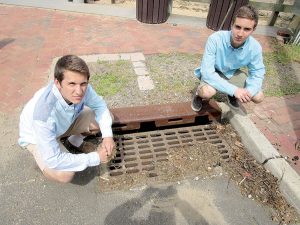By Joseph Sapia
FAIR HAVEN – Tyler Lubin and Noah Tucker, both 17, grew up on the Navesink River – boating, fishing, kayaking and rowing. “What makes these towns great is you have the river,” Tyler said. “The identity of Fair Haven is this river.”
A few months ago, they got talking about the river’s deterioration. “We wanted to do something about it,” Noah said. So, the two young men – borough residents and juniors at Rumson-Fair Haven High School – did some online research and developed a “Save the Navesink River” plan. Their idea was to raise money and place tube-like booms around storm drains and filter out the fecal bacteria in water runoff before it enters the Navesink River and its tributaries.
They went to an online fundraising site Friday, April 22, and set a goal of $6,500, and reaching the halfway point four days later. Their initial aim is to boom 100 storm drains, with 9 feet of boom per drain, upstream of Fair Haven to the Swimming River area.
That would leave about $1,100 left over to pay for shipping and hidden costs, they said.
Call this putting the cart before the horse, but their plan is to begin raising money before getting formal approval.
Tyler said he thought the funding demonstrated that “people care.”
“If we went with no funding, they” – meaning the authorities – “likely wouldn’t take it so seriously,” Noah said.
The two said they will update the funding website and donors can get their money back if they do not approve. The two expect to meet with a representative of the Monmouth County Division of Planning in the upcoming days, according to both sides.

“It’s nice to see young adults are interested in the environment,” said William D. Kastning, executive director of the Monmouth Conservation Foundation. “I like the fact these guys are kind of entrepreneurial go-getters to help the Navesink.”
“The fecal coliform levels are increasing,” Tyler said. The polluting of the river with fecal bacteria, whose origins are human and animal, is caused by water runoff carrying animal droppings and waste from poorly operating septic systems into the river.
How much of an impact will the storm drain booms have?
“Technically, not the most effective solution,” said Hendrik F. “Rik” van Hemmen, a borough resident who is vice president of the Navesink Maritime Heritage Association.
Yet, van Hemmen applauded Noah and Tyler’s enthusiasm. “I think it’s thrilling there’s kids willing to do this,” van Hemmen said. He added the project may have a greater impact than realized: “The biggest impact of their work will increase the public awareness of the existence of this problem.”
Kastning had similar thoughts.
“It, hopefully, creates an awareness,” Kastning said. “Any little effort that creates an awareness is a good thing.”
The filters are pliable composite material covered in a mesh sock, the sock clipped at each end. Then, the filter is secured in place around the grate. The filters will continue working for perhaps two years, they said.
“If it’s making a noticeable difference cleaning out the river, I’d say it’s well worth it,” Tyler said. “We’re very confident our plan can work.”
After they got talking, the boys researched pollution and solutions to controlling it, then found a place to buy the filters. If fecal bacteria can be cut off from flowing into the river, the river will clean itself of the bacteria already there, they said.
For now, the fecal bacteria keeps creeping in.
“It keeps getting replenished every time it rains,” Noah said.














